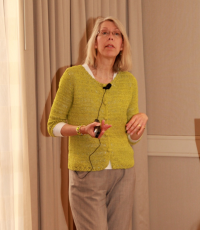August 4
Session O: Teach-back: Make It an Always Event
0 comments
August 4
0 comments

Mary Ann Abrams, MD, MPH; Nationwide Children’s Hospital
Dr. Abrams began her workshop by showing a true-life video of a mother who had overmedicated her son because she had misunderstood the doctor’s instructions. While the story ended without serious injury to the child, it still effectively illustrated the danger of miscommunication. Dr. Abrams then solicited stories of provider/patient misunderstandings from the audience.
With everyone thus actively engaged, Dr. Abrams set out her objectives for participants of the workshop:
Dr. Abrams then showed a video of a doctor explaining to a mother and son how to use an inhaler for the boy’s exercise-induced asthma. The doctor used technical jargon, rushed through the explanation, and at the end, asked only if the mother and patient had any questions. Participants then discussed the possible results of the doctor’s poor communication, and how he could have handled things differently.
Dr. Abrams talked about teach-back as a quality and safety factor in health care practice and cited a growing body of research that supports the use of teach-back in various settings and populations. She explained what teach-back is:
Dr. Abrams introduced participants to the Always Use Teach-back! Toolkit and its two modules: the first for training oneself to use teach-back, and the second for coaching others.
Dr. Abrams described teach-back as in investment, not an add-on to healthcare. She showed various tools within the toolkit for gauging conviction and confidence among providers in their use of teach-back. She emphasized that it is important to circle back to staff trained in teach-back, to observe how they are doing, to encourage and reward their efforts.
Dr. Abrams recommended incorporating teach-back into training, processes, intakes, order sets, and documentation of visits. She gave some additional tips for using teach-back well:
The workshop ended with participants splitting up into small groups to either practice teach-back role-playing or discuss how to implement teach-back in their organizations, followed by a group discussion of the exercise.
Always Use Teach-back! Toolkit:
http://www.teachbacktraining.org
Tags